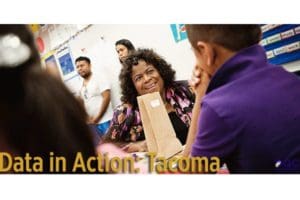Tacoma Public Schools in Washington State was facing an unacceptable graduation rate of 55 percent. Every high school within its borders had been declared a dropout factory, and the community felt voiceless. In 2012 Superintendent Carla Santorno and her team started a plan of action that would change the face of public education in the district.
When developing a culture of data use in a school district, the support of stakeholders is crucial. Parents and the community must see the effort as a friendly tool to support ongoing improvement. Superintendent Santorno and her team created a “safe space” for community members to dig into less-than-perfect performance data at open school board meetings. The district worked with the community to develop a common language and definitions. Working hand-in-hand with school leaders and community partners, Santorno and her team then re-evaluated the existing plan for the district and identified data-driven goals for student academic success, safety, early learning, and community partnerships.
Fostering a safe space for data use within schools is also crucial to creating a supportive culture. “There are two things that inhibit people from using data. Number one is that they’re scared of it. Number two is once they understand what it says, they don’t know what to do with it,” Santorno said. Data literacy training and professional development were vital to ensuring teachers overcame those concerns. Principals were trained as data leaders to ensure information was used to inform conversations and inspire action. Tacoma also created time and space for collaboration between teachers across grade levels to examine data.
The district was able to set and work toward their goals because it had the information it needed to measure progress. Since then Tacoma Public Schools has seen increases in student achievement, partnerships, and community support. The community has a voice again, and students are on track for success. Graduation rates have climbed for four consecutive years and are up 23 percent since 2010. Additionally, participation in college-level courses has increased more than 20 percent in two years, and more than 90 percent of 11th and 12th graders take the PSAT and SAT college entrance exams.
“The more we can look at data that’s not just a test score that also tell a story that we’re building success, I think that will help build a better system,” Santorno said.
Find out more about great data use in service of student learning in Data Works for Students.


